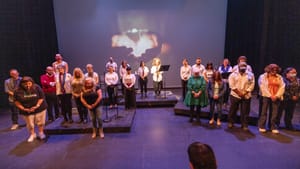Stay in the Loop
BSR publishes on a weekly schedule, with an email newsletter every Wednesday and Thursday morning. There’s no paywall, and subscribing is always free.
Philly storytellers tackle suicide stigma
Mural Arts and First Person Arts present Embracing the Light

Know before you read: this piece discusses mental illness and suicide. We note resources at the end.
“Bipolar depression is like a boomerang.” That was one of many devastatingly accurate takes on mental illness shared by storytellers at Embracing the Light, a March 16 event presented by Mural Arts and First Person Arts (FPA).
Show director Daralyse Lyons writes for BSR, and our executive director Neil Bardhan doubles as FPA’s director of applied storytelling, so this event was on my radar, but given the subject matter, it took me weeks to decide whether or not I wanted to go. The topic (an unusual one for a storytelling event) was suicide.
I did get there because it’s rare to find a room full of people who are talking openly about this—or people who are listening. I also knew that by being there myself and writing about it during Mental Health Awareness Month, I could help document the event and increase its reach, even though this work is difficult for me: I live with bipolar disorder myself.
Facing suicide and stigma
Suicide can feel impossible to talk about, but it’s an unavoidable topic for people with bipolar. Our risk of suicide is twice as high as it is for people with depression, and especially if we don’t get adequate treatment, about 20 percent of us will die by suicide, and up to 60 percent will attempt it at least once. It’s not easy to be public about an illness with stats like that. It’s also not easy to find humane media representations of people with mental illness, whether onscreen or onstage.
While social media is now full of therapists (credentialed or not) and people who talk openly about being in therapy, I don’t believe that modernity has made much of a dent in the stigma around severe forms of mental illness. I feel it when there are still professionals (like pilots and doctors) who must avoid diagnosis and treatment to hang onto their jobs. I feel it when immigration laws deny residency to people with psychiatric conditions. I feel it when some healthcare providers treat us like convicts. I feel it when US prisons hold more mentally ill people than hospitals do. I feel it when people on social media claim that a walk in the woods would cure patients like me, or that my life-saving meds are a big pharma hoax. Have you tried yoga? Have you cut out gluten? Have you tried just being happy?
“A heavy coat through the seasons of my life”
At Embracing the Light, which had two well-attended performances at FringeArts, almost two dozen storytellers took to the stage, including a mother who recounted the “unfathomable” devastation of losing her son (a college-age Eagle Scout) to suicide and invited the audience to say his name (“Len”). Another chronicled her sister’s recovery from suicidality.
“My time in this life is frozen while the rest of the world moves on,” another said of her loss—an apt description of the way trauma feels. She described the pain as “worn like a heavy coat through the seasons of my life.” Sometimes it’s buttoned, sometimes not. Sometimes it hangs by the door. But “I embrace the person I’ve become because of the tragedy.”
Another described the impossibility of surviving on hope alone. Sometimes hope runs out, but we have to find other ways to keep moving. Pain, depression, and numbness on their own don’t cause suicide, she also explained. The danger is when they become normal inside you, and others can’t acknowledge what you’re going through.

One of my favorite storytellers emphasized the practical difficulty of getting help before you’re in a crisis: “No, I’m not suicidal, but it’s getting harder to keep going.” Why don’t we have more preventive resources and better healthcare access, instead of waiting until a psychiatric emergency hits?
More about the medical reality
There are some areas I wish the event had explored more deeply, like the medical realities of managing mental illness. I am living proof that bipolar, for example, is a highly treatable illness (despite negative media portrayals), but it requires commitment to medication, therapy, and lifestyle, and for some of us, hospitalization when needed.
I take psych meds four times a day to manage my symptoms while minimizing side effects like dizziness, nausea, blurred vision, and sleepiness (to name a few). It works for me, but this balancing act can be a serious obstacle to treatment. At least one storyteller acknowledged this reality. We are the lucky ones: many people don’t have access to doctors or medications at all.
I have been hospitalized twice. Sometimes inpatient psychiatric care is needed. But it’s also true that some modern psych wards are inhumane places. Would you hurry to a hospital if you knew the doors would lock behind you, and you’d be forced to surrender all your usual comforts and connections, crowded among strangers likewise in crisis and surveilled day and night without a moment of privacy? Bruising shame or even trauma can linger long afterward—not to mention the medical debt. Seeking psychiatric care can feel impossible, and if our healthcare system won’t evolve, no amount of awareness or love will address these problems.
Religious triggers
Embracing the Light featured several stories centering Christian faith. This was difficult for me as a former Christian—especially when, as at least one storyteller detailed, these faith communities are rife with painful stigma. I was deeply troubled by one father’s story about his bipolar son who died by suicide.
The father is a Christian but said his son professed atheism—except for the time his son described a religious experience during a manic episode. Instead of honoring the values his son espoused while he was in a stable frame of mind, the storyteller recounted a cross-country road trip to leave his son’s ashes at a site where he claimed, while manic, to have witnessed God.
“Our bodies are shells for our souls,” the storyteller said, adding that his son is now “free from his pain and sorrow.” I encountered many similar statements about illness and disability during my own Christian upbringing. But the idea that disabled people (including those with mental illness) will be better off in an afterlife, instead of having our needs met here and now, is ableist. And if you’re fighting suicidal ideation, the belief that death will free you—or that loved ones will find relief, meaning, or closure with your demise—can be downright dangerous, regardless of your religious status.
Holding on to my story
Of course, grieving people have the right to process and share their own experiences however they choose, including in religious terms. But the Christian father’s story triggered one of my own worst fears as a person who’s living with bipolar. If I die (especially in a state of mind altered by my illness), will someone else publicly co-opt my story in a way that is contrary to my own values?
Nobody is immortal. At some point, we all have to surrender our own narratives to our survivors. But why do that before I have to? And that’s a great reason to keep going, even on the darkest days. It’s one of the most powerful realizations of a good night of storytelling. I applaud Mural Arts and FPA for this program. I saw myself reflected in many of the stories, and I hope those who are not fighting this battle have a new window on us, as well.
If you or a loved one are experiencing a suicidal crisis or emotional distress, text or call 988 or the Mental Health Crisis Line at (215) 625-6440. Visit healthymindsphilly.org for a variety of mental health resources, including help for veterans, LGBTQ folks, and survivors of domestic violence.
Sign up for our newsletter
All of the week's new articles, all in one place. Sign up for the free weekly BSR newsletters, and don't miss a conversation.

 Alaina Johns
Alaina Johns